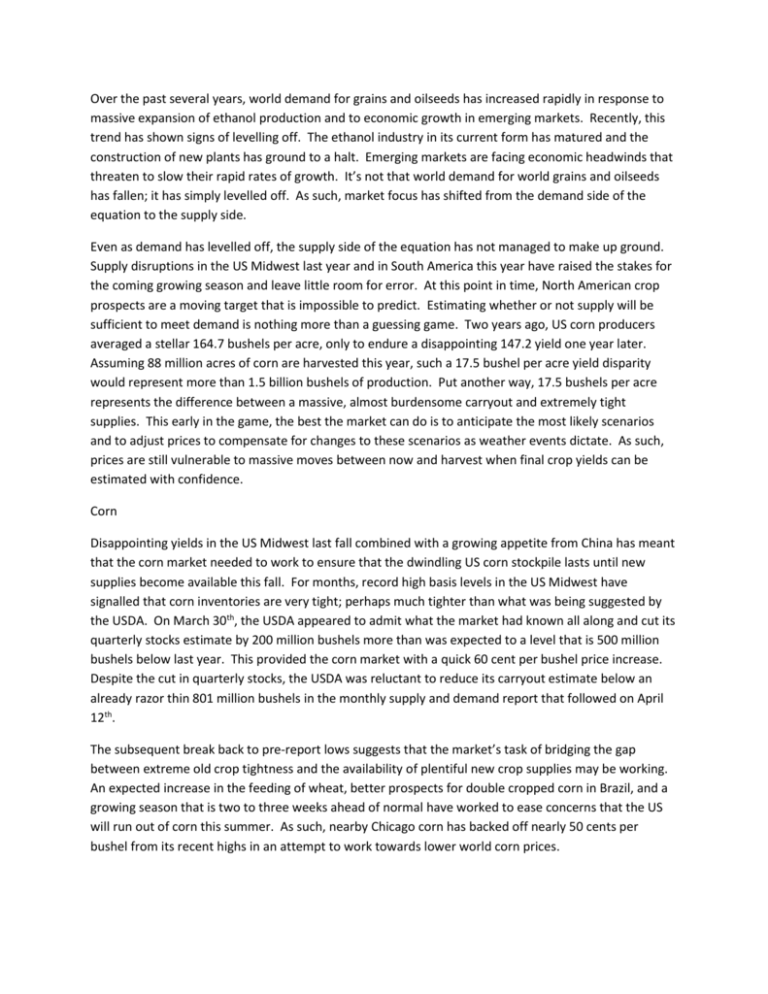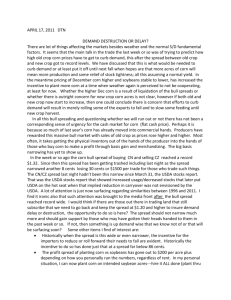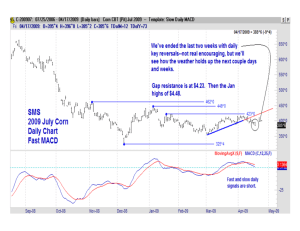Over the past several years, world demand for grains and oilseeds
advertisement

Over the past several years, world demand for grains and oilseeds has increased rapidly in response to massive expansion of ethanol production and to economic growth in emerging markets. Recently, this trend has shown signs of levelling off. The ethanol industry in its current form has matured and the construction of new plants has ground to a halt. Emerging markets are facing economic headwinds that threaten to slow their rapid rates of growth. It’s not that world demand for world grains and oilseeds has fallen; it has simply levelled off. As such, market focus has shifted from the demand side of the equation to the supply side. Even as demand has levelled off, the supply side of the equation has not managed to make up ground. Supply disruptions in the US Midwest last year and in South America this year have raised the stakes for the coming growing season and leave little room for error. At this point in time, North American crop prospects are a moving target that is impossible to predict. Estimating whether or not supply will be sufficient to meet demand is nothing more than a guessing game. Two years ago, US corn producers averaged a stellar 164.7 bushels per acre, only to endure a disappointing 147.2 yield one year later. Assuming 88 million acres of corn are harvested this year, such a 17.5 bushel per acre yield disparity would represent more than 1.5 billion bushels of production. Put another way, 17.5 bushels per acre represents the difference between a massive, almost burdensome carryout and extremely tight supplies. This early in the game, the best the market can do is to anticipate the most likely scenarios and to adjust prices to compensate for changes to these scenarios as weather events dictate. As such, prices are still vulnerable to massive moves between now and harvest when final crop yields can be estimated with confidence. Corn Disappointing yields in the US Midwest last fall combined with a growing appetite from China has meant that the corn market needed to work to ensure that the dwindling US corn stockpile lasts until new supplies become available this fall. For months, record high basis levels in the US Midwest have signalled that corn inventories are very tight; perhaps much tighter than what was being suggested by the USDA. On March 30th, the USDA appeared to admit what the market had known all along and cut its quarterly stocks estimate by 200 million bushels more than was expected to a level that is 500 million bushels below last year. This provided the corn market with a quick 60 cent per bushel price increase. Despite the cut in quarterly stocks, the USDA was reluctant to reduce its carryout estimate below an already razor thin 801 million bushels in the monthly supply and demand report that followed on April 12th. The subsequent break back to pre-report lows suggests that the market’s task of bridging the gap between extreme old crop tightness and the availability of plentiful new crop supplies may be working. An expected increase in the feeding of wheat, better prospects for double cropped corn in Brazil, and a growing season that is two to three weeks ahead of normal have worked to ease concerns that the US will run out of corn this summer. As such, nearby Chicago corn has backed off nearly 50 cents per bushel from its recent highs in an attempt to work towards lower world corn prices. Anticipation of a massive corn harvest this fall has kept a lid on new crop prices. At this point in time however, the prospect of a large crop remains just that – a prospect. The USDA is suggesting that farmers will plant a record 95.9 million acres of corn and a rapid start to the spring supports this idea and current estimates suggest trend line yields in the low 160’s. Given that soil moisture in the Western Corn Belt is low and that many of the additional acres this year will come from less productive land, it is quite conceivable that estimates could fall into the summer months. The old crop carryout leaves absolutely no margin for error and the corn market will be highly sensitive to any weather problems that may develop this summer. That said, recent rains have helped to stabilize soil moisture levels and every day that goes by without any threats to the crop will serve to reduce some of the weather premium already factored in to the market. Here in Ontario, old crop corn basis is holding steady as processors are still well bought up for the near term. Fortunately for those with corn to sell, basis levels at US processors are strong and some lower vomitoxin corn is making its way across the border. Unfortunately, there are relatively few export opportunities for corn that is higher in vomitoxin. This higher vomitoxin corn has proven to be the Achilles heel of the 2011 crop and has kept Ontario basis levels well below those seen in the US. New crop basis levels are also steady, reflecting the prospect of a large crop in Ontario. Producers in some areas of the province have gotten off to a very early start to planting. Despite recent price action in favour of soybeans, we have not yet heard of much switching away from corn. Soybeans The steady rise in the soybean market since the beginning of the year can be attributed to the seemingly never ending reductions in South American crop prospects and to strong demand from China. The USDA’s estimates for global soybean stocks have fallen by more than 12 million metric tonnes since February. As such, the soybean market continues to be the price leader, but bull markets need to be fed every day and the market is growing weary of further cuts to South America’s production. Just like last year, the Chicago soybean market has stumbled in the mid 14 dollar range. With sufficient inventories to get to harvest and the South American growing season wrapping up, market focus should shift to new crop prospects. The USDA suggests one million fewer soybean acres will be planted in the US this year versus last which will do little to replenish global soybean stocks. The survey upon which this estimate was based was conducted in several weeks ago when prices pointed to more corn. Will producers respond to price signals that have since swung in favour of soybeans? Not necessarily. For some reason, the American farmer just loves to grow corn and the weather this year is encouraging him to plant lots of it. What is more likely is that producers will look to increase their double-cropped soybean acres. Given that the US wheat crop is a couple of weeks ahead of schedule and soybean prices are strong, US producers will have lots of incentive to do so. If wheat can be harvested early and soil moisture can remain adequate, US producers may plant as many as 7 million soybean acres after wheat, or nearly 3 million more than what they would in a typical year. A few extra acres combined with an average crop in North America may be just be enough to supply the world’s needs until South American supplies become available in early 2013. Given strong prices and recent weakness in their currency, Brazilian producers have tremendous incentive to ramp up production next year. Let’s not get ahead of ourselves though. We still have 5 months of weather to contend with before our harvest and we haven’t even seen what the summer weather will offer. Local soybean basis levels have weakened slightly as heavy producer selling amidst high cash prices has enabled end users to secure good coverage levels into the summer months. A few vessels are being loaded for export in the coming weeks and have served to put a floor under local basis levels. Producers may not have many soybeans left to sell, but end users may not need to stretch very far this summer either as long as the prospect of an early harvest remains reasonable. New crop soybean basis levels have also been pressured slightly lower by producer selling. The smaller crop in South America should help to keep Ontario’s soybeans competitive this fall and competition between exporters and end users should continue to be of benefit to producers over the coming months. Wheat In the absence of threatening weather and slipping corn prices, wheat prices have been grinding lower. The US wheat crop – in a critical yield determining stage of growth – has benefitted from good moisture coverage and is progressing well. Losses in the EU from winter cold snaps are still being assessed, but regular showers in the region are helping to stabilize production in the region. Continued use of wheat in feed rations should help to reduce massive world supplies over time, but supplies are still large enough that wheat prices are unlikely to break from corn anytime soon. Ontario wheat basis levels have been softening somewhat. Shrinking carries in the term structure of wheat futures has reduced the incentive for handlers to purchase and store wheat. At the same time, Ontario’s relatively weak old crop corn basis means that wheat basis levels have needed to soften in order to be competitive in feed markets. Assuming the Canadian dollar remains steady, wheat basis levels are not likely to lose much ground from here because Ontario’s harvest will likely be small.









